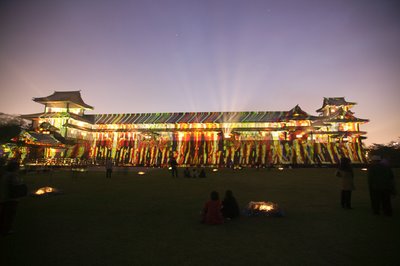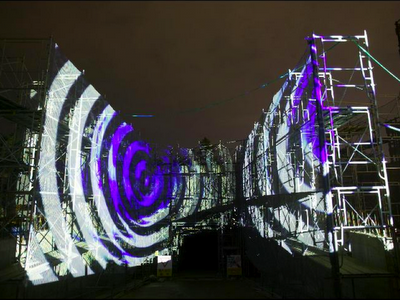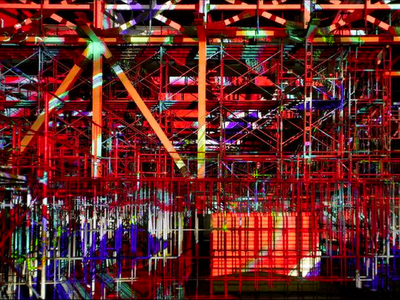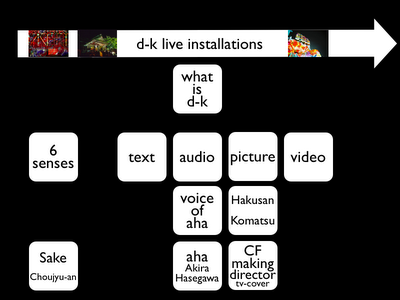Exposure Time: two media art installations
by Thomas Daniel, an architect nad partner of FOBA, Kyoto, Japan
(an atricle from
"ARCHI" magazine, #01 2004)

Although very different in execution and expression, two recent media art installations in Japan (Akira Hasegawa's "Digital Kakejiku" and Rafael Lozano-Hemmer's "Amodal Suspension" shared a number of characteristics: both were nighttime, outdoor public spectacles, both used digital data as the raw material and artificial light as the expressive medium, and both partially relinquished artistic control to computer randomization. In each case, invisible aspects of the digital realm were made visible, rendered in light at scales and speeds available to human perception. Immanent global networks were localized, instantaneous electronic transitions were decelerated; space was shrunk as time was stretched. Ephemeral events rather than physical objects, their magnitude was more temporal than spatial. Their existence relied on duration, or more precisely, on delay: a slowing of the speed of light.
The "refresh rate" of the human brain is somewhere around 1/16th of a second. Above this threshold, sequences of individual events can no longer be consciously distinguished. A clicking sound faster than 16 Hertz becomes a low bass note; an animated cartoon slowed to fewer than 16 frames per second resolves into a series of individual images. The illusory movement of cinema is the result of interpolation between still pictures by the viewer's brain. Media artist Akira Hasegawa jokes that Disney should return half our money, as we are doing half the work.
Digital Kakejiku-
The theme of Hasegawa's own artistic project, entitled 'Digital Kakejiku' (or D-K), is the perception of that interval. Over three
nights in April 2003, Hasegawa projected a series of unrelated abstract pictures (all previously created by him with a computer) onto the exterior surfaces of Kanazawa Castle, complemented by music from composer Ryoji Ikeda piped through thirty speakers distributed across the castle grounds - the intent was to totally immerse the audience.
Although the images were changed at one-minute intervals, there were no abrupt transitions. They were smoothly blended into one another by a computer constantly calculating the intervening states and updating the projection. The source images were lost in the flux, merging into a single seamless animation. There was no goal, no evolution, no climax. The beginning and end moments were arbitrary. The gradual movement was barely noticeable. At a glance, it seemed perfectly still, but look away for a minute, and it would be totally transformed.

The Kanazawa Castle installation was the first major D-K event, repeated in October at the construction site of Kanazawa's 21st Century Museum of Contemporary Art (designed by Kazuyo Sejima and Ryue Nishizawa). Several other D-K installations have been realized or are in planning, but Hasegawa has been developing the technique itself for a decade. His early experiments used computer monitors, and later shifted to video projectors. Hasegawa sees D-K as an architectural material, able to actively engage and transform any context, applicable at scales ranging from urban event to computer screensaver. It is practically impossible to freeze-frame exactly the same image twice, and the possibilities of infinite variation have already attracted wide attention: D-K images have been commissioned to convert identical, mass-produced items into unique artifacts, from Mitsubishi Bank credit cards to Issey Miyake fabrics to the billboards at the Nagano Winter Olympics.
The kakejiku is a hanging scroll, usually found in the tokonoma alcove of the traditional Japanese house. They are changed frequently, according to the season, the mood or the guest that particular day. Like the original kakejiku, Hasegawa sees D-K as fundamentally relational and participatory: "It is the combination of sensory perception and subconscious awareness. The changing scenery of the sunset, the 'space' between haiku lines, the 'space' between sounds, and the 'space' between times - none are tangible, but all are part of experiencing 'the moment'. When experiencing D-K, the things that you see and feel all come from you."(1)
There is a composition by Frank Zappa entitled 'The Girl in theMagnesium Dress' which he describes as being made of 'digital dust'.(2) It was created on the Synclavier (a combined synthesizer / sampler / sequencer) by taking the digital file of an existing composition and stripping away the numbers representing pitch and duration (ie melody and rhythm), leaving only peripheral data indicating the specific dynamics for each note. This became the rhythm file for the new piece; by assigning pitches to the 'dust', the composer shifted inaudible, abstract data into the realm of audibility.
Analogous to Zappa's musical construction, Rafael Lozano-Hemmer's 'Amodal Suspension' project used digital data streams as 'found objects' to provide rhythms for the modulation of light, thereby shifting invisible electronic information into the realm of visibility. E-mail messages sent via the Amodal Suspension website were encoded into
sequences of light pulses at a rate of four letters per second (two per second in the case of Japanese characters). Variations in brightness were determined by the statistical frequency of the given letter in its original language, and the spaces between words became moments of darkness. The messages were not forwarded; instead, their addressees were notified by e-mail that messages were 'waiting for them in the sky of Yamaguchi'.
'Amodal Suspension' was in operation for three weeks in November 2003, to mark the opening of the Yamaguchi Center for Arts and Media (designed by Arata Isozaki in collaboration with the performance art troupe Dumb Type). Reminiscent of the artist's earlier 'Vectorial Elevation' (Mexico City, 1999), the installation hardware was an array of twenty computer-controlled searchlights distributed around an empty field adjacent to the YCAM. The encoded messages were passed amongst the searchlights at random: two beams would intersect, and the pattern would be picked up by the second beam as the first was extinguished. Up to ten messages were in circulation at any given moment, a 'literal flash mob', as Brian Massumi described it.(3) With each exchange, the lights were angled higher and the beams faded in intensity, until the message was accessed from the website by its addressee, or possibly by another observer. The original text was then briefly displayed on an electronic billboard fixed to the exterior of the YCAM, using computer software to translate between English and Japanese. Anyone anywhere with a PC or mobile phone was able to contribute, and dedicated access pods were installed at the YCAM and at sympathetic institutions from San Paolo to New Delhi, including V2 in Rotterdam, ZKM in Karlsru"he, Eyebeam in New York, the Sendai Mediatheque, the Dessau Bauhaus and the MIT Media Lab. A realtime view of the sky over Yamaguchi City was projected on the ceiling of each venue.

The visual impact of this robotic choreography was simultaneous fluid grace and nervous energy, a web of random strobing that appeared to be on the brink of emergent order. The installation was like a holding pen for delayed communication, rendered temporarily illegible; it was not information that was suspended in the sky, but more like its aura: the shadow of the network.
The messages being used were all triggered by the installation itself (and the majority were trivial or nonsensical); if no one had participated, nothing would have happened. This perhaps explains why the artist says the work is about loneliness rather than communication - he was not tracing existing connections, but revealing the desire to make contact. However, Lozano-Hemmer did not intend the participatory aspect of 'Amodal Suspension' as an abdication of his own artistic control:
'Like other artists who grew up with Postmodernism, I used to believe that we were finally being liberated from authorship [...] now I argue that there are crucial decisions made in the creation of an interactive platform that are intensely personal and directed. One's obsessions, myths, nightmares, values, and biases are clearly reflected even in the most open pieces [...] the pleasure of the work is still in seeing how surprising behaviors might emerge during interaction. We engineer a platform, but people build their own relations, be it party or funeral.'(4) Indeed, his input was mostly parametric rather than direct, a gentle guiding of the viewer in the hope that the results would be mutually entertaining. You could not wish for a more affable media artist; Lozano-Hemmer said goodbye to the citizens of Yamaguchi with an outdoor barbecue party where he took the role of DJ.
Exposure time-
The communal, public nature of both 'Amodal Suspension' and 'Digital Kakejiku' contained a hint of ritual, like modern-day secular ceremonies. In adding yet another layer of imagery to the saturated urban environment, their virtue is to be both unnecessary and inexplicable, pure spectacle for its own sake. Lozano-Hemmer again: 'Cities - especially cities like Tokyo - need more images. My notion is that our globalized cities are infested by the same image. This image
has a very well-defined 'topdown' commercial purpose. My call is for a radical departure: more images! More self-representation, more questions, more destabilization of prevalent patterns, more uncontrollability, more silence, more abstraction, more uselessness.'(5)

Both installations used digital technology to introduce vitality and unpredictability, apparently transcending Walter Benjamin's famous assertion that mechanical (and by extension, digital) reproduction erodes the singularity, or 'aura', of the work of art. It seems that here singularity is ensured by animation, something that Benjamin himself intuited in his essay 'Little History of Photography'.(6) He suggests that the artistic value of photography is a function of how
well it captures the temporal dimension, equating the shrinking of exposure time with a corresponding loss of 'aura'. The exposure times of early photographs were measurable in hours, and the resulting stills were unavoidably imbued with traces of turbulence, a virtual dynamism collapsed into static images; there is no such thing as a still life.
Reproducing time-dependent art in the pages of a magazine is problematic to say the least. Ideally, these photographs capture a sense of the original continuity and movement, but they are still no substitute. This is work that must be experienced in its full singularity, locality and temporality: media art, unmediated.
Tom Daniell
1. See, for example, Tor Norretranders, "The User Illusion: Cutting
Consciousness Down To Size", Penguin Books 1999, pp138-139.
2. Akira Hasegawa, Digital Kakejiku project statement.
3. 'The Girl In The Magnesium Dress' was originally released on Ensemble Intercontemporain, 'Boulez Conducts Zappa: The Perfect Stranger' (EMI,1984), and later on Ensemble Modern, 'The Yellow Shark' (Rykodisc, 1993).
4. Brian Massumi, from a lecture at YCAM on November 2, 2003.
5. Rafael Lozano-Hemmer, from a conversation with the author at YCAM on October 26, 2003.
6. ibid.
7. Walter Benjamin, 'Little History of Photography' in Selected Writings: 1927-1934, Harvard University Press 1999, pp 507-530.





